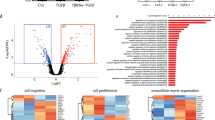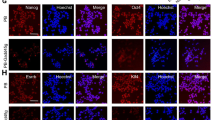Abstract
Nanog is a transcription factor required for maintaining the pluripotency of embryonic stem cells, and is not expressed in most normal adult tissues. However, recent studies have indicated that Nanog is overexpressed in many types of human cancers, including breast cancer. To elucidate the physiological roles of Nanog in tumorigenesis, we developed an inducible Nanog transgenic mouse model, in which the expression of Nanog in adult tissues can be induced via LoxP/Cre-mediated deletion. Our findings indicate that overexpression of Nanog in the mammary gland is not sufficient to induce mammary tumor. However, when coexpressed with Wnt-1 in the mouse mammary gland, it promotes mammary tumorigenesis and metastasis. In this context, Nanog promotes the migration and invasion of breast cancer cells. Microarray analysis has shown that the ectopic expression of Nanog deregulates the expression of numerous genes associated with tumorigenesis and metastasis, such as the PDGFRα gene. Our findings demonstrate the involvement of Nanog in breast cancer metastasis, and provide the basis for the reported correlation between Nanog expression and poor prognosis of human breast cancer patients. As Nanog is not expressed in most adult tissues, these findings identify Nanog as a potential therapeutic target in the treatment of Nanog-expressing metastatic breast cancer.
This is a preview of subscription content, access via your institution
Access options
Subscribe to this journal
Receive 50 print issues and online access
$259.00 per year
only $5.18 per issue
Buy this article
- Purchase on Springer Link
- Instant access to full article PDF
Prices may be subject to local taxes which are calculated during checkout






Similar content being viewed by others
References
Jemal A, Bray F, Center MM, Ferlay J, Ward E, Forman D . Global cancer statistics. CA Cancer J Clin 2011; 61: 69–90.
Polakis P . Wnt signaling in cancer. Cold Spring Harb Perspect Biol 2012; 4: doi:pii: a008052.
Taipale J, Beachy PA . The Hedgehog and Wnt signalling pathways in cancer. Nature 2001; 411: 349–354.
Kelleher FC, Fennelly D, Rafferty M . Common critical pathways in embryogenesis and cancer. Acta Oncol 2006; 45: 375–388.
Sonoshita M, Aoki M, Fuwa H, Aoki K, Hosogi H, Sakai Y et al. Suppression of colon cancer metastasis by Aes through inhibition of Notch signaling. Cancer Cell 2011; 19: 125–137.
Chambers I, Colby D, Robertson M, Nichols J, Lee S, Tweedie S et al. Functional expression cloning of Nanog, a pluripotency sustaining factor in embryonic stem cells. Cell 2003; 113: 643–655.
Mitsui K, Tokuzawa Y, Itoh H, Segawa K, Murakami M, Takahashi K et al. The homeoprotein Nanog is required for maintenance of pluripotency in mouse epiblast and ES cells. Cell 2003; 113: 631–642.
Boyer LA, Lee TI, Cole MF, Johnstone SE, Levine SS, Zucker JP et al. Core transcriptional regulatory circuitry in human embryonic stem cells. Cell 2005; 122: 947–956.
Loh YH, Wu Q, Chew JL, Vega VB, Zhang W, Chen X et al. The Oct4 and Nanog transcription network regulates pluripotency in mouse embryonic stem cells. Nat Genet 2006; 38: 431–440.
Hatano SY, Tada M, Kimura H, Yamaguchi S, Kono T, Nakano T et al. Pluripotential competence of cells associated with Nanog activity. Mech Dev 2005; 122: 67–79.
Kohler EE, Cowan CE, Chatterjee I, Malik AB, Wary KK . NANOG induction of fetal liver kinase-1 (FLK1) transcription regulates endothelial cell proliferation and angiogenesis. Blood 2011; 117: 1761–1769.
Nichols J, Zevnik B, Anastassiadis K, Niwa H, Klewe-Nebenius D, Chambers I et al. Formation of pluripotent stem cells in the mammalian embryo depends on the POU transcription factor Oct4. Cell 1998; 95: 379–391.
Pesce M, Gross MK, Scholer HR . In line with our ancestors: Oct-4 and the mammalian germ. Bioessays 1998; 20: 722–732.
Yeom YI, Fuhrmann G, Ovitt CE, Brehm A, Ohbo K, Gross M et al. Germline regulatory element of Oct-4 specific for the totipotent cycle of embryonal cells. Development 1996; 122: 881–894.
Almstrup K, Hoei-Hansen CE, Wirkner U, Blake J, Schwager C, Ansorge W et al. Embryonic stem cell-like features of testicular carcinoma in situ revealed by genome-wide gene expression profiling. Cancer Res 2004; 64: 4736–4743.
Ezeh UI, Turek PJ, Reijo RA, Clark AT . Human embryonic stem cell genes OCT4, NANOG, STELLAR, and GDF3 are expressed in both seminoma and breast carcinoma. Cancer 2005; 104: 2255–2265.
Gibbs CP, Kukekov VG, Reith JD, Tchigrinova O, Suslov ON, Scott EW et al. Stem-like cells in bone sarcomas: implications for tumorigenesis. Neoplasia 2005; 7: 967–976.
Hart AH, Hartley L, Parker K, Ibrahim M, Looijenga LH, Pauchnik M et al. The pluripotency homeobox gene NANOG is expressed in human germ cell tumors. Cancer 2005; 104: 2092–2098.
Chiou SH, Wang ML, Chou YT, Chen CJ, Hong CF, Hsieh WJ et al. Coexpression of Oct4 and Nanog enhances malignancy in lung adenocarcinoma by inducing cancer stem cell-like properties and epithelial-mesenchymal transdifferentiation. Cancer Res 2010; 70: 10433–10444.
Siu MKY, Wong ESY, Kong DSH, Chan HY, Jiang L, Wong OGW et al. Stem cell transcription factor NANOG controls cell migration and invasion via dysregulation of E-cadherin and FoxJ1 and contributes to adverse clinical outcome in ovarian cancers. Oncogene 2013; 32: 3500–3509.
Wagner KU, Wall RJ, St-Onge L, Gruss P, Wynshaw-Boris A, Garrett L et al. Cre-mediated gene deletion in the mammary gland. Nucleic Acids Res 1997; 25: 4323–4330.
Tsukamoto AS, Grosschedl R, Guzman RC, Parslow T, Varmus HE . Expression of the int-1 gene in transgenic mice is associated with mammary gland hyperplasia and adenocarcinomas in male and female mice. Cell 1988; 55: 619–625.
Yang J, Mani SA, Donaher JL, Ramaswamy S, Itzykson RA, Come C et al. Twist, a master regulator of morphogenesis, plays an essential role in tumor metastasis. Cell 2004; 117: 927–939.
Leis O, Eguiara A, Lopez-Arribillaga E, Alberdi MJ, Hernandez-Garcia S, Elorriaga K et al. Sox2 expression in breast tumours and activation in breast cancer stem cells. Oncogene 2012; 31: 1354–1365.
Andrae J, Gallini R, Betsholtz C . Role of platelet-derived growth factors in physiology and medicine. Genes Dev 2008; 22: 1276–1312.
Jechlinger M, Sommer A, Moriggl R, Seither P, Kraut N, Capodiecci P et al. Autocrine PDGFR signaling promotes mammary cancer metastasis. J Clin Invest 2006; 116: 1561–1570.
Eckert MA, Lwin TM, Chang AT, Kim J, Danis E, Ohno-Machado L et al. Twist1-induced invadopodia formation promotes tumor metastasis. Cancer Cell 2011; 19: 372–386.
Johnson DS, Mortazavi A, Myers RM, Wold B . Genome-wide mapping of in vivo protein-DNA interactions. Science 2007; 316: 1497–1502.
Fields S . Molecular biology. Site-seeing by sequencing. Science 2007; 316: 1441–1442.
Ouyang Z, Zhou Q, Wong WH . ChIP-Seq of transcription factors predicts absolute and differential gene expression in embryonic stem cells. Proc Natl Acad Sci USA 2009; 106: 21521–21526.
Chen X, Xu H, Yuan P, Fang F, Huss M, Vega VB et al. Integration of external signaling pathways with the core transcriptional network in embryonic stem cells. Cell 2008; 133: 1106–1117.
Park SJ, Nakai K . A regression analysis of gene expression in ES cells reveals two gene classes that are significantly different in epigenetic patterns. BMC Bioinformatics 2011; 12 (Suppl 1): S50.
Subramanian A, Tamayo P, Mootha VK, Mukherjee S, Ebert BL, Gillette MA et al. Gene set enrichment analysis: a knowledge-based approach for interpreting genome-wide expression profiles. Proc Natl Acad Sci USA 2005; 102: 15545–15550.
Herman JG, Meadows GG . Increased class 3 semaphorin expression modulates the invasive and adhesive properties of prostate cancer cells. Int J Oncol 2007; 30: 1231–1238.
Esselens C, Malapeira J, Colome N, Casal C, Rodriguez-Manzaneque JC, Canals F et al. The cleavage of semaphorin 3C induced by ADAMTS1 promotes cell migration. J Biol Chem 2010; 285: 2463–2473.
Lee EK, Han GY, Park HW, Song YJ, Kim CW . Transgelin promotes migration and invasion of cancer stem cells. J Proteome Res 2010; 9: 5108–5117.
Nagata T, Shimada Y, Sekine S, Hori R, Matsui K, Okumura T et al. Prognostic significance of NANOG and KLF4 for breast cancer. Breast Cancer (doi: 10.1007/s12282-012-0357-y).
Ishiguro T, Sato A, Ohata H, Sakai H, Nakagama H, Okamoto K . Differential expression of nanog1 and nanogp8 in colon cancer cells. Biochem Biophys Res Commun 2012; 418: 199–204.
Ibrahim EE, Babaei-Jadidi R, Saadeddin A, Spencer-Dene B, Hossaini S, Abuzinadah M et al. Embryonic NANOG activity defines colorectal cancer stem cells and modulates through AP1- and TCF-dependent mechanisms. Stem Cells 2012; 30: 2076–2087.
Zhang J, Wang X, Chen B, Xiao Z, Li W, Lu Y et al. The human pluripotency gene NANOG/NANOGP8 is expressed in gastric cancer and associated with tumor development. Oncol Lett 2010; 1: 457–463.
Jeter CR, Badeaux M, Choy G, Chandra D, Patrawala L, Liu C et al. Functional evidence that the self-renewal gene NANOG regulates human tumor development. Stem Cells 2009; 27: 993–1005.
Jeter CR, Liu B, Liu X, Chen X, Liu C, Calhoun-Davis T et al. NANOG promotes cancer stem cell characteristics and prostate cancer resistance to androgen deprivation. Oncogene 2011; 30: 3833–3845.
Thiery JP, Acloque H, Huang RY, Nieto MA . Epithelial-mesenchymal transitions in development and disease. Cell 2009; 139: 871–890.
Guo W, Keckesova Z, Donaher JL, Shibue T, Tischler V, Reinhardt F et al. Slug and sox9 cooperatively determine the mammary stem cell state. Cell 2012; 148: 1015–1028.
Mani SA, Guo W, Liao MJ, Eaton EN, Ayyanan A, Zhou AY et al. The epithelial-mesenchymal transition generates cells with properties of stem cells. Cell 2008; 133: 704–715.
Xiao C, Srinivasan L, Calado DP, Patterson HC, Zhang B, Wang J et al. Lymphoproliferative disease and autoimmunity in mice with increased miR-17-92 expression in lymphocytes. Nat Immunol 2008; 9: 405–414.
Cho RW, Wang X, Diehn M, Shedden K, Chen GY, Sherlock G et al. Isolation and molecular characterization of cancer stem cells in MMTV-Wnt-1 murine breast tumors. Stem Cells 2008; 26: 364–371.
Liu DP, Song H, Xu Y . A common gain of function of p53 cancer mutants in inducing genetic instability. Oncogene 2010; 29: 949–956.
Barbosa-Morais NL, Dunning MJ, Samarajiwa SA, Darot JF, Ritchie ME, Lynch AG et al. A re-annotation pipeline for Illumina BeadArrays: improving the interpretation of gene expression data. Nucleic Acids Res 2010; 38: e17.
Du P, Kibbe WA, Lin SM . lumi: a pipeline for processing Illumina microarray. Bioinformatics 2008; 24: 1547–1548.
Sharov AA, Dudekula DB, Ko MS . CisView: a browser and database of cis-regulatory modules predicted in the mouse genome. DNA Res 2006; 13: 123–134.
Campeau E, Ruhl VE, Rodier F, Smith CL, Rahmberg BL, Fuss JO et al. A versatile viral system for expression and depletion of proteins in mammalian cells. PLoS One 2009; 4: e6529.
Acknowledgements
We thank Y Li for providing the Wnt-1 transgenic mice. This work was supported by NIH grants (CA94254 and CA124834) to YX and by the Intramural Research Program of the National Cancer Institute, National Institutes of Health.
Author information
Authors and Affiliations
Corresponding author
Ethics declarations
Competing interests
The authors declare no conflict of interest.
Additional information
Supplementary Information accompanies this paper on the Oncogene website
Supplementary information
Rights and permissions
About this article
Cite this article
Lu, X., Mazur, S., Lin, T. et al. The pluripotency factor nanog promotes breast cancer tumorigenesis and metastasis. Oncogene 33, 2655–2664 (2014). https://doi.org/10.1038/onc.2013.209
Received:
Revised:
Accepted:
Published:
Issue Date:
DOI: https://doi.org/10.1038/onc.2013.209
Keywords
This article is cited by
-
Silencing Notch4 promotes tumorigenesis and inhibits metastasis of triple-negative breast cancer via Nanog and Cdc42
Cell Death Discovery (2023)
-
Identification of Nanog as a novel inhibitor of Rad51
Cell Death & Disease (2022)
-
MUC1-C activates the PBAF chromatin remodeling complex in integrating redox balance with progression of human prostate cancer stem cells
Oncogene (2021)
-
Gadd45g initiates embryonic stem cell differentiation and inhibits breast cell carcinogenesis
Cell Death Discovery (2021)
-
Polyploid giant cancer cells, stemness and epithelial-mesenchymal plasticity elicited by human cytomegalovirus
Oncogene (2021)



